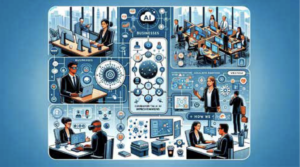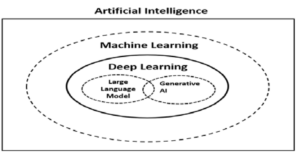Over the past three decades, from 1990 to the present, we have witnessed substantial advancements in Information Technology. The mid-1990s and early 2000s were pivotal in web development, fundamentally connecting countries on a unified platform. The early 2000s saw the emergence and growth of various social media platforms, which have profoundly influenced our society and culture. By the mid-2010s, numerous companies began incorporating Artificial Intelligence1 (AI) in different sectors, including developing autonomous vehicles, enhancing online e-commerce platforms to boost sales, and improving medical imaging techniques. Over the same duration, we have observed improvements in machines, including enhancements in memory and CPU capabilities. We now have more powerful processors (GPUs) supporting various data types. A common thread among these innovations has been the pivotal role of data and powerful machines, which are leading the way for AI-driven automation (see Figure 1).

Figure 1. Representation of Transformation to Businesses and Employee
December 2022 marked a significant milestone in this trajectory, highlighted by the emergence of ChatGPT,2 which accelerated the race in generative AI and related technologies. This period has seen the introduction of innovative tools such as Google Bard,3 Gemini, AWS Bedrock, MidJourney,4 and DALL.E.
This article explores how Artificial Intelligence is revolutionizing business operations, employee roles, and our overall approach to work.
Artificial Intelligence (AI) refers to the ability of machines to process, interpret, and apply information in a manner akin to human cognitive functions, distinguishing it from natural intelligence exhibited by humans and other animals.

Figure 2. The relationship between AI, Machine Learning, and deep learning
Machine learning is a subset of AI, and deep learning (Natural Language Processing (NLP), Convolutional Neural Network (CNN), and Recurrent Neural Network (RNN)) is a subset of machine learning (see Figure 2). Deep and machine learning have two essential types: supervised learning (labeled data) and unsupervised learning.
Business Transformation
1. Revolutionizing Industries: The Impact of AI Across Various Business Sectors
Businesses span diverse sectors in national and international arenas, including healthcare, retail, financial services, manufacturing, media, arts, and education. Each of these industries has its unique requirements for sustaining growth and competitiveness. As Artificial Intelligence (AI) continues to evolve, each sector is keen to harness its potential. For instance, healthcare organizations are utilizing AI to enhance patient care and improve diagnostics, such as obtaining more precise imaging of the lungs. By analyzing patient histories, imaging, and lab results, AI enables doctors to make more informed treatment decisions. In retail, companies leverage AI to derive deeper insights from consumer data, aiding in targeted marketing strategies and revenue growth. The media industry is adopting AI for enriched communication experiences, while the automotive sector is exploring AI for advanced automation.
Generative AI,5 in particular, is set to transform the data and analytics landscape, boosting productivity and expediting delivery processes. Organizations can capitalize on these AI capabilities to improve end-user experiences with data, enabling faster and more informed decision-making. Rather than replacing data and analytics professionals, generative AI will augment their efforts, allowing more organizations to benefit from data-driven insights.
A common trend across these sectors is the increasing adoption of advanced AI-enabled chatbots, enhancing customer interaction and service. Similarly, virtual stores and business entities are being reimagined with AI integration, paving the way for innovative and efficient business models.
2. Revolutionizing the Digital Landscape: How IT-Enabled Products and Companies are Shaping for the Future
The recent advancements in Artificial Intelligence (AI) have opened new avenues and provided a strategic direction for software companies. Recognizing the immense potential of AI, these companies are significantly increasing their investments in artificial intelligence technologies. The main aim of this surge in investment is to enhance their products and remain competitive in the rapidly evolving market. We are witnessing a trend where many companies integrate AI capabilities into their offerings. This integration is a response to market demand and a strategic move to stay ahead in the technology race.
Including AI in products and services is leading to unprecedented levels of automation. This automation goes beyond mere efficiency; it’s about creating more intelligent, intuitive systems to learn, adapt, and make decisions, potentially revolutionizing how businesses operate and interact with their customers. The AI-driven transformation is not limited to large corporations; even startups and mid-sized companies rapidly adopt AI to innovate and enhance their service offerings.
Furthermore, this shift towards AI-focused strategies is reshaping the IT landscape, leading to the emergence of new business models and redefining customer expectations. Companies that effectively harness the power of AI are poised to offer more personalized, efficient, and impactful solutions, setting new standards in the technology sector. As AI continues to evolve, it promises to unlock even more possibilities, driving the future of IT-enabled products and companies toward an increasingly automated and intelligent horizon.
3. Transformation Information Technology (IT) Service Industry: Bridging the AI Skill Shortage
IT-enabled service providers have been dynamically transforming their offerings to meet the evolving needs of their customers. Embracing a multi-stream approach, these providers are focusing on several key areas. Firstly, they are investing in the training of consultants on AI-related topics, ensuring their teams are well-versed in the latest technological advancements. This knowledge equips them to understand better and meet the complex demands of clients in an AI-driven business environment.
Secondly, these providers are dedicated to developing AI-driven tools tailored for their clients. These tools are designed to assist businesses in daily operations, offering innovative solutions that streamline processes, enhance decision-making, and improve overall efficiency.
Overall, the drive towards AI integration and enhanced IT security is a testament to IT-enabled service providers’ proactive and forward-thinking stance. By continuously evolving and adapting their services, they stay relevant in a competitive market and pave the way for future innovations in IT services.
Transforming Employee
1. Employees are Eager to Acquire New AI Skills
Many employees are consistently eager to learn new skills and technologies, and AI is a significant source of this motivation. We have observed many individuals engaging in blogging and writing about their respective domains, actively seeking to integrate and relate their expertise with AI concepts. This trend reflects a keen interest in understanding and utilizing AI, demonstrating a proactive approach towards staying relevant and innovative in their fields. Employees are learning about AI and exploring ways to apply it practically, enhancing their professional capabilities and contributing to the broader discussion in their areas of expertise. This enthusiasm for AI is a positive indicator of a workforce that is adaptable, forward-thinking, and ready to embrace the challenges and opportunities presented by emerging technologies.
2. Organizations Anticipate Increased Self-Training Among Employees Through AI Tools
There is often a lengthy learning curve, particularly with new hires, and employers invest significantly in their training and development. However, with AI, there is an expectation that employees will increasingly take the initiative in their skill development. Utilizing AI tools, they can gain essential skills and become productive more quickly than before. This shift towards self-directed learning, facilitated by AI, will likely streamline the training process, making it more efficient and cost-effective for organizations. Employees are expected to leverage these AI resources to enhance their capabilities, reducing the time and resources traditionally required for employer-led training. This trend represents a shift towards a more agile and adaptive workforce, where individuals proactively engage with emerging technologies to accelerate their professional growth and contribute more effectively to their organizations from the outset.
3. New Cycle of Employment in the Era of Automation
Every business is unique, and AI will impact them all. While we may see some jobs become irrelevant, new jobs will emerge because of automation. Consider the example of the self-driving car: it doesn’t mean that all drivers’ jobs will be wiped out; instead, it will create new avenues and opportunities. A similar transformation is expected to occur in other areas as well.
Transforming How We Work
1. AI Tools for Workplaces
In today’s workplaces, we can access many AI tools that enhance various aspects of business operations. This article will focus on some of the most recent and impactful tools. Tools like ChatGPT and Google Bard are at the forefront of content creation, data analysis, troubleshooting, and providing suggestions. Similarly, DALL·E and Midjourney offer innovative artistic and image-creation capabilities. Tools like Gemini and AWS Bedrock 6 streamline the process of application development. Microsoft’s GitHub Copilot 7 revolutionizes code generation and offers real-time coding assistance. Beyond these, numerous products are dedicated to data security, ensuring businesses can safeguard their digital assets effectively. This list is just the tip of the iceberg in the rapidly expanding universe of AI tools.
2. Overcoming the Blank Page Dilemma with AI Assistance: Boosting Productivity Across Various Tasks
AI technology is revolutionizing how we approach initial document creation, offering solutions to the often-daunting ‘blank page’ problem. By utilizing generative AI, individuals and organizations can efficiently generate first drafts of various documents, including emails and reports. This capability significantly streamlines the writing process, enabling users to kickstart their tasks with a solid foundation, which they can refine and customize.
The impact of generative AI extends far beyond just drafting documents; it plays a pivotal role in enhancing overall productivity at multiple levels. From improving communication to augmenting work processes, AI’s contributions are multifaceted. It empowers users to focus on higher-level creative and analytical tasks by handling the initial, time-consuming stages of document creation. This advancement in AI technology is not just a tool for efficiency; it’s a catalyst for innovation and productivity in the modern workplace.
3. Problem-Solving Across Industries
Depending on your industry, you can tackle specific challenges effectively. For instance, in the software industry, you can troubleshoot code and review logs to identify and resolve issues. This skill is crucial for maintaining the functionality and efficiency of software applications. The ability to problem-solve in this context is not just about fixing immediate issues; it also involves a proactive approach to anticipating potential problems and implementing preventive measures. This kind of targeted problem-solving is essential in various industries, as it ensures that operations run smoothly and efficiently, contributing to overall business success.
Ethical Considerations for Workplaces
The list of ethical considerations is extensive. Here are a few points derived from my research on workplace guidelines:8
- Work closely with AI vendors for data security and privacy
- Don’t share PII and PCI data with AI tools
- Educate Employees on the pros and cons of AI tools
- Don’t put company intellectual property at AI Tools
Conclusion
The advent of Artificial Intelligence, including specialized fields such as Generative AI, is set to impact the business landscape profoundly. This technology will drive the evolution of businesses, leading to enhanced experiences and benefits for end-users and customers. Companies are expected to accelerate the trend towards automation, ushering in a new era of efficiency and innovation.
At the same time, this technological shift will positively influence the workforce. Employees will find their roles and methods of working transformed by AI, improving productivity and job satisfaction. Although there are ethical considerations to be addressed, the overarching effect of AI and automation on society promises to be beneficial, heralding advancements in various sectors and contributing to overall societal progress.
Endnotes
1 Artificial intelligence, https://bit.ly/3unWgk8 , 04:36, December 26 2023
2 Introducing ChatGPT, https://openai.com/blog/chatgpt, Nov 30, 2022
3 Sundar Pichai, An important next step on our AI journey, Google Blog, February 06, 2023, https://bit.ly/3OygO03.
4 Enterprise DNA Experts, What is Midjourney and How to Use It – Blog, October 17, 2023, https://bit.ly/3UuzGAV.
5 What is Generative AI, https://bit.ly/3w6Sn3H.
6 What is Amazon Bedrock? https://bit.ly/3SNaV1N.
7 The AI coding assistant elevating developer workflows, https://github.com/features/copilot
8 Workplace Guidelines, https://bit.ly/3HNDEgx.
References
Dhoni, Pan. “Unleashing the Potential: Overcoming Hurdles and Embracing Generative AI in It Workplaces: Advantages, Guidelines, and Policies,” 2023, doi: 10.36227/techrxiv.23696709.v1
P.G. Michalopoulos, et al.: Vehicle detection video through image processing: the Auto-scope system, 21 – 29 (1991), doi: 10.1109/25.69968.
Koul, Anirudh, “Chapter 1: Exploring the Landscape of Artificial Intelligence, What Is AI,” Practical Deep Learning for Cloud, Mobile, and Edge: Real-World AI; Computer-Vision Projects Using Python, Keras; Tensorflow, O’Reilly Media, Sebastopol, CA, 2019, pp. 6–7
Video Link: https://youtu.be/XNs7t9lDvSE.
While the journey of generative AI might seem daunting now, it mirrors the trajectory of many transformative technologies of the past. Like any pioneering technology, subsequent advancements and refinements often overshadow the early hurdles. Collaborative efforts between researchers, developers, and industry experts will be instrumental in navigating these challenges. Over time, as the technology becomes more integrated into various sectors, its true potential will unfold. The future promises improved efficiency and innovative applications we have yet to envision.



